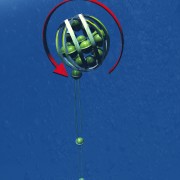A very busy day, offshore and onshore
13 September 2021 – Still a day packed of activities today!
The status at the moment is that all interlink cables have been layed down on the sea floor and two detection units have been deployed and connected to the junction box. The detection units are still furled on their launcher vehicles; they will be allowed to unfurl tomorrow – since the launcher vehicle has to be recovered from the ship after it reaches the surface, it is better to perform this operation in the daylight.
Pre-unfurling functional tests performed from the onshore control station show that those first two detection units are in good order.
Deployments of the next detection units will continue during the night.






